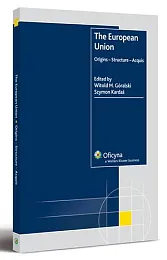The European Union. Origins - Structure - Acquis
The European Union. Origins - Structure - Acquis
Opis publikacji
The European Union. Origins-Structure-Acquis is a textbook tailored to serve the needs of foreign students taking courses in humanities at Polish Universities. It was written by researchers from the Institute of International Relations of the University of Warsaw.
The textbook is divided into three parts, covering crucial institutional and procedural aspects of the European Union. The first part serves as an introduction to the integration process. It looks at the genesis of this phenomenon, reforms of the European Communities undertaken over the years as well as the recent enlargements of the European Union. The pending reform based on the Treaty of Lisbon is also presented. Part two of the textbook is devoted to the political and institutional structure of the European Union. The centre of gravity remains with the model of European integration, based on the institutional system and legal order of the European Union. The implemen...
The European Union. Origins-Structure-Acquis is a textbook tailored to serve the needs of foreign students taking courses in humanities at Polish Universities. It was written by researchers from the Institute of International Relations of the University of Warsaw.
The textbook is divided into three parts, covering crucial institutional and procedural aspects of the European Union. The first part serves as an introduction to the integration process. It looks at the genesis of this phenomenon, reforms of the European Communities undertaken over the years as well as the recent enlargements of the European Union. The pending reform based on the Treaty of Lisbon is also presented. Part two of the textbook is devoted to the political and institutional structure of the European Union. The centre of gravity remains with the model of European integration, based on the institutional system and legal order of the European Union. The implementation of ambitious goals laid down for the integration endeavour is analysed in the third part of the book. They are achieved in the form of economic integration based on the internal market and common policies, as well as Common Foreign and Security Policy and Justice and Home Affairs (including Police and Judicial Cooperation in Criminal Matters). Particular attention is paid to the achievements of the integrat on process, with an emphasis on the second and third pillar of the European Union.
The fact that the textbook is mainly addressed to foreign students taking courses offered in English at Polish Universities does not preclude its potential usefulness for Polish readers who express interest in the functioning of the European Union.
Witold M. Góralski, Prof. Ph.D. habil.
Institute of International Relations of the University of Warsaw
Paweł Borkowski, Ph.D.
Adjunct Assistant Professor at the Institute of International Relations of the Universityof Warsaw
Katarzyna Kołodziejczyk, Ph.D.
Adjunct Assistant Professor at the Institute of International Relations of the Universityof Warsaw
Joanna Starzyk-Sulejewska, Ph.D.
Adjunct Assistant Professor at the Institute of International Relations of the Universityof Warsaw
Szymon Kardaś, MA
Ph.D. student at the Institute of International Relations of the University of Warsaw
Joanna Sapieżko, MA
Ph.D. student at the Institute of International Relations of the University of Warsaw


